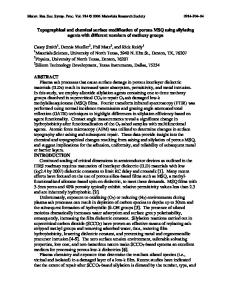Photo Chemical Modification of the ZnSe Surface
- PDF / 722,912 Bytes
- 6 Pages / 391.5 x 607.5 pts Page_size
- 46 Downloads / 348 Views
It was demonstrated that structures with lateral dimensions of 150-200 nm could be etched at Si and GaAs substrates. In our group we started in situ experiments on ZnSe, which is very promising material for IR optics, sensing and blue LEDs [4-5]. An efficient surface reaction of chlorine with cleaved ZnSe was observed. ZnCl2 layers of variable thickness have been obtained. In the present work we have attempted to study pressure and photon energy dependencies for the photon induced reaction of chlorine and oxygen with ZnSe in more details. EXPERIMENT The setup for exposure of ZnSe substrates was mounted at the RIBER LAS 600 AES/XPS spectrometer. The spectral resolution was typically about 1.0 eV. The base pressure in the main spectrometer chamber did not exceed 10' Torr. Ion gun sputtering was used for the layer by layer thickness and composition determination. The stainless steel sample chamber for the light and active gas exposure was evacuated with cryogenic pump to 10' Torn. The samples were irradiated with D2 (15 Watt) and mercury (100 watt) lamps through the LiF (105 nm cutoff), CaF 2 (125 nm), quartz (180 nm) and glass (330 rnm) filters. The constant chlorine flow at the pressures from 102 to 10 mBar was provided using a highvacuum gas handling system made of stainless steel. The purity of Cl 2 was of 99.996%. Cleavages 273 Mat. Res. Soc. Symp. Proc. Vol. 555 ©1999 Materials Research Society
of (110) surfaces of ZnSe crystals were subjected to the photochemical exposure without any previous treatment, i.e. they had a thin (about 3 nm) oxide layer on the surface. To produce structures, masks made from nickel mesh (50x50 pm 2 square, the wire thickness 10 pm) were used. The reaction product morphology and composition were studied by scanning electron microscopy and X-ray microanalysis using an electron microscope JSM-820 with a Link ANIO/85S microanalytical system. The reaction products were studied also by X-ray photoelectron spectroscopy (XPS) using XPS800 KRATOS spectrometer. The vacuum in the chamber was 108 Torr. Photoelectrons were excited by AlKa radiation, the X-ray gun power was 15 kVx20 mA. A hemispheric electrostatic analyzer analyzed the kinetic energy of photoelectrons. The spectra were subjected to a mathematical treatment including smoothing, constant and variable background subtraction (Shirley's method), removing of X-ray line broadening form (iterative deconvolution) and decomposition of complex line into its constituting Gaussians. RESULTS C1, / ZnSe system: wavelength and pressure dependence, composition The results for wavelength dependence of the quantum efficiency Q with D2 lamp are given in Table I. Quantum efficiency was determined as ratio of the number of reaction products in the layer deposited to the number of incident photons. Table I. The quantum efficiency calculated for different cutoff filters Filter Photon energy cutoff, eV Quantum efficiency, Q
Glass 4.0
Quartz 6.1
CaF 2 9.6
LiF 11.9
0.1
0.85
0.9
1.1
It is clearly seen that visible light doesn't enhance the surface
Data Loading...








